During pregnancy, your body undergoes various changes to ensure that your little one gets all the nutrients needed for proper development. To achieve this, your body does an amazing thing – it grows a brand new, but temporary, organ called the placenta.
In this article, you’d learn all you need to know about the placenta; what it is, how it’s formed, its functions, and possible complications.
Table of contents:
- What is Placenta?
- When Does the Placenta Form?
- Functions of The Placenta
- How Long Does The Placenta Stay?
- What Happens To The Placenta After Birth?
- Possible Placental Complications
- Symptoms of Placenta Complications
- Risk Factors for Placenta Complications During Pregnancy
- How to Prevent Placenta Complications
- Conclusion
What is Placenta?
The placenta is a temporary organ that develops during pregnancy. This unique organ supplies oxygen and nutrients to your baby during pregnancy. In addition to this, it also removes waste products and carbon dioxide from your little one’s circulatory system.
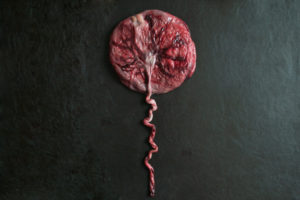
The placenta is called a fetomaternal organ because it has two components:
- The Fetal Part
- The Maternal Part
In normal conditions, the placenta attaches to the wall of your uterus (often at the side or on the top) and is connected to your baby through the umbilical cord. However, in placenta previa, the placenta blocks the cervix and obstructs the path that the baby should come out from during vaginal delivery.
When Does the Placenta Form?
The placenta begins to develop in the third week of pregnancy. This involves changes in the wall of the uterus where implantation occurred and the chorionic sac (a bag-like structure that contains the embryo). Furthermore, the blood vessels in the uterus undergo various alterations that also contribute to the formation of this important organ.

In most cases, this special organ is fully developed by the eighth week of pregnancy when it takes over hormone production, nutrient transport, and gaseous exchange. At this point, you would likely get a positive pregnancy test result due to hCG production from the placenta.
Functions of The Placenta
1. Oxygen Transport
During pregnancy, your little one depends on you for his/her oxygen supply. The truth is, this gaseous exchange is one of the primary functions of the placenta. The large surface area of the placenta allows oxygen-poor blood from the fetus to mix with oxygen-rich blood from the mother. This way, your baby has a steady supply of the right amount of oxygen needed to function and grow.
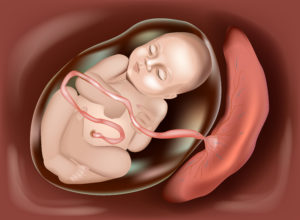
2. Nutrient Transport
Another important function of the placenta is nutrient delivery from the mother to the baby. Nutrients absorbed into the blood from the mother’s diet, are delivered to the growing baby through the placenta and umbilical cord. That’s how all of a pregnant mum’s meals get to the baby without them having to take a single bite!
Some of the nutrients transported include:
- Glucose
- Water
- Amino Acids
- Vitamins
3. Hormonal Function
The placenta secretes important pregnancy hormones that support the baby’s development. Human Chorionic Gonadotrophin, which is the major hormone produced by the placenta, maintains pregnancy and stops menstruation after implantation has occurred. Furthermore, hCG serves as the basis of pregnancy testing.
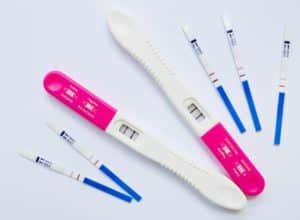
In addition to hCG, the placenta secretes other important hormones like:
- Human Chorionic Somatomammotrophin (hCS): which functions in breast development and improves breast milk supply after childbirth.
- Progestrone: This really important placental hormone maintains the pregnancy and prevents spontaneous abortion. In addition, progesterone increases uterine secretions thereby promoting nutrient supply to the developing embryo.
4. Waste Removal
The placenta serves as the only route for your baby’s waste removal during pregnancy. Waste products of metabolism and development are passed into the amniotic fluid and to the placenta before it is eventually removed from the mother’s body via urination or defecation.
How Long Does The Placenta Stay?
Although each pregnancy is unique, the placenta usually begins functioning fully by the eighth week of pregnancy and lasts for the entire duration of pregnancy.
What Happens To The Placenta After Birth?
In vaginal delivery, the placenta is also delivered through the birth canal after the baby has been delivered. Medical experts often refer to this process as the third stage of labor.
After childbirth, you would continue to experience mild contractions until the placenta separates from the wall of the uterus and is expelled. To aid this process, your health care provider may administer a drug called oxytocin or gently massage your lower abdomen until the placenta is removed. You might be asked to give a final push to expel the placenta in some cases.
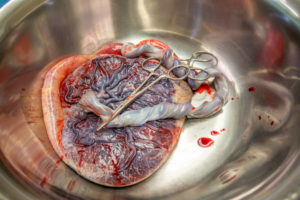
During a C-section, your doctor would remove the placenta from your uterus as a part of the surgical procedure.
After delivery, your doctor would examine it to make sure that there’s no remnant placenta tissue left in your uterus as this may cause postpartum hemorrhage (excessive bleeding after delivery) or uterine infections if left unchecked.
If you want to, you can ask to see the placenta before it is disposed of.
Possible Placental Complications
Placenta Previa
This is an important medical condition that occurs when the placenta blocks the cervix. When this happens, the placenta blocks the birth canal which is the baby’s route during vaginal delivery. Depending on its exact position in the uterus, placenta previa may be marginal, partial, or complete.

Women with placenta previa often experience light to heavy bleeding, accompanied with abdominal cramps or serious back pain.
Although there is no drug to cure placenta previa, this placental complication can be managed by limiting blood loss until the baby can be safely delivered. A Cesarean section would be conducted to deliver the baby and remove the placenta in cases where the bleeding is heavy and incessant.
Placental Abruption
This happens when the placenta peels away from the uterine wall before delivery. Placental abruption can reduce the amount of oxygen getting to your baby during pregnancy, which can lead to poor growth, brain injury, low birth weight, or premature birth.
When it occurs, placental abruption often requires an emergency cesarean delivery (even if the baby is not up to term). If the baby is still preterm and the separation is minimal, close monitoring, bed rest, and medications to help the baby survive outside the uterus are recommended until it is safe enough to deliver the baby.
Placenta Accreta
This happens when the placenta grows too deeply into the uterus. In this instance, it becomes very difficult to separate the placenta from the uterus during delivery. Therefore, this condition can lead to excessive bleeding from the uterus. Sadly, this condition is life-threatening and may require surgical removal of the uterus (hysterectomy) to stop the bleeding.
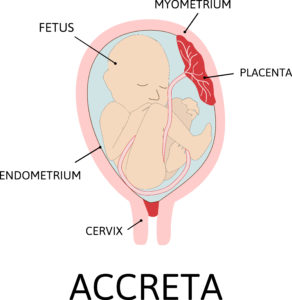
Other placental complications include:
Symptoms of Placenta Complications
In most cases, women with any of the placental complications mentioned earlier often experience:
- Vaginal bleeding
- Abdominal pain
- Back Pain
- Severe uterine contractions
If you notice any of these symptoms at any stage of your pregnancy, please contact your doctor immediately.
Risk Factors for Placenta Complications During Pregnancy
Sometimes, a normal and healthy pregnancy may eventually lead to a placenta complication.
However, medical researchers have identified the following as the major risk factors for placenta complications during pregnancy:
- Increased maternal age (above 35)
- Genetics
- High blood pressure
- Multiple pregnancies
- Previous C-section
- Substance (Alcohol or Illicit Drug) use
- Abdominal trauma
Thankfully, attending regular antenatal clinics would provide your doctor with all the info he/she needs to identify these risk factors if they exist and monitor you closely
How to Prevent Placenta Complications
Here’s the good news:
You can reduce the possibility of these complications during pregnancy by:
- Avoiding alcohol or illicit drugs
- Checking your blood pressure regularly
- Following a healthy pregnancy diet
- Attending regular antenatal clinics
- Reporting any strange symptoms or feeling to your healthcare provider
Conclusion
In conclusion, it is important to remember that the placenta is an important and unique organ of pregnancy. It ensures efficient oxygen and nutrient supply to your baby during pregnancy. However, various medical conditions could affect it in the course of pregnancy.
If you notice any of the symptoms of placenta complications mentioned in this article, please contact your doctor immediately. You can read more on Eating Placenta here and positive signs after embryo transfer
We are always here for you.
References
- How your fetus grows during pregnancy. (2020).
acog.org/patient-resources/faqs/pregnancy/how-your-fetus-grows-during-pregnancy - Perlman N. (2019). Retained placenta after vaginal delivery: Risk factors and management. DOI:
10.2147/IJWH.S218933 - Benirschke K, Kaufmann P: Pathology of the Human Placenta, ed 4, New York, 2000, Springer-Verlag.
- Cross JC: Formation of the placenta and extraembryonic membranes, Ann N Y Acad Sci 857:23, 1998.
- Kazandi M: Conservative and surgical treatment of abnormal placentation: report of five cases and review of the literature, Clin Exp Obstet Gynecol 37:310, 2010.
- Cunningham FG, Leveno KJ, Bloom SL, et al: Williams’ Obstetrics, ed 23, New York, 2009, McGraw-Hill.

